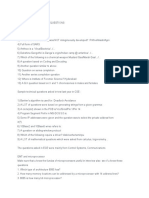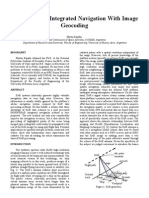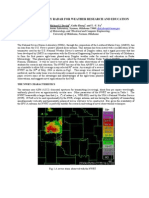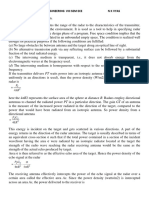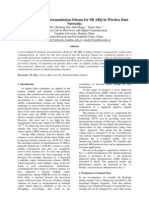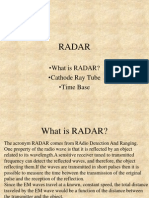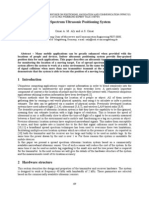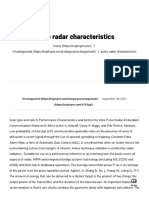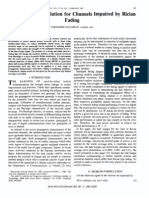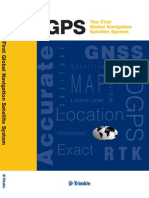Kalman Tracking and Bayesian Detection For RADAR RFI Blanking
Kalman Tracking and Bayesian Detection For RADAR RFI Blanking
Uploaded by
Ha PvCopyright:
Available Formats
Kalman Tracking and Bayesian Detection For RADAR RFI Blanking
Kalman Tracking and Bayesian Detection For RADAR RFI Blanking
Uploaded by
Ha PvOriginal Description:
Original Title
Copyright
Available Formats
Share this document
Did you find this document useful?
Is this content inappropriate?
Copyright:
Available Formats
Kalman Tracking and Bayesian Detection For RADAR RFI Blanking
Kalman Tracking and Bayesian Detection For RADAR RFI Blanking
Uploaded by
Ha PvCopyright:
Available Formats
1
Kalman Tracking and Bayesian Detection for
RADAR RFI Blanking
Weizhen Dong, Brian D. Jeffs,
Department of Electrical and Computer Engineering, Brigham Young University, Provo, UT 84606;
wzhdong@hotmail.com, bjeffs@ee.byu.edu
and
J. Richard Fisher
National Radio Astronomy Observatory, 520 Edgemont Road, Charlottesville, VA 22903-2524;
rsher@gb.nrao.edu
AbstractL-Band observations at the Green Bank Tele-
scope (GBT) and other radio observatories are plagued
with interference from pulsed aviation RADAR transmis-
sions. One remaining problem is that even when strong
direct path pulses and nearby xed clutter echoes are
removed, there are still weaker aircraft echoes present
which can corrupt the data. In this paper we present
an algorithm which improves aircraft echo blanking by
forming a Kalman lter tracker to follow the path of a
sequence of echoes observed on successive RADAR antenna
sweeps. The tracks developed for each aircraft can be used
to predict regions (in bearing and range) for the next
expected echoes, even before they are detected. The data
in these regions can then be blanked in real time without
waiting for the pulse peak to arrive. Additionally, we
present a new Bayesian algorithm which combines tracker
and pulse detector operations to enable more sensitive
weak pulse acquisition. The developed track information
is used to form a spatial prior probability distribution
for the presence of the next echoes. Regions with higher
probability are processed with a lower detection threshold
to pull out low level pulses without increasing the overall
probability of false alarm detection.
Index TermsRFI mitigation, Kalman tracking,
Bayesian detection, radio astronomy.
I. INTRODUCTION
R
ADIO astronomical observation is polluted by a
wide range of radio frequency interference (RFI).
Astronomers and engineers are facing unprecedented
challenges as they attempt to solve the problem of RFI
mitigation.
For example, air surveillance RADAR transmissions
such as those from the ARSR-3 system occur in the
important red shifted Hydrogen line observation fre-
quency range from 960-1400 MHz. These signals may
This work is supported by the National Scicence Foundation grant
number AST-9987339
dramatically disturb radio astronomical observations, and
have been reported to be a signicant problem at the
Green Bank Telescope (GBT) [1] [2] [3], Arecibo [4] [5],
and other observatories . However, the induced pollution
is impulsive and transient, so for radio astronomy ob-
servation, one solution is to time-blank by simply not
including RADAR-pulse-corrupted data samples during
spectrum estimation [6] [1]. Time blanking has also
been used to mitigate interference from mobile wireless
communications services [7] [8] [9]. It has also been pro-
posed that once detected, RADAR pulses can be removed
by parametric signal subtraction without discarding data
[5].
Fig. 1. Pulse intensity as a function of delay from the directly
arriving pulse
To illustrate the interference problem addressed in this
paper, we present some 1292 MHz data recorded at
the GBT which clearly shows the interfering RADAR
signal. Some valuable analysis of this real-world data
is provided in [2][3]. Figure 1 shows pulse intensity
as a function of delay relative to the rst arriving
pulse. Strong pulses can be seen out to a delay of 135
2
microseconds, most of which are due to reections from
the hilly terrain around the GBT. These can typically
be excised using time window blanking. The group of
returns at 430 microseconds is from an aircraft, and
blanking it is more problematical since it is not present
at this same location during each successive transmit
antenna sweep.
There are two approaches to time-blanking which
we will call respectively, time window blanking and
detected pulse blanking. Strong direct-path pulses and
nearby xed terrain clutter echoes have a predictable
repetition cycle and can be removed by simple time
window blanking. In this approach a xed set of time
intervals, synchronized to the RADAR pulse repetition
rate, are removed from the data during each transmit
antenna sweep cycle. However, aircraft echoes arrive at
arbitrary times due to aircraft motion, and thus must
be detected before they can be blanked. Detected pulse
blanking is used in this case to remove a window of
data surrounding each detected aircraft echo, including
transmit antenna beampattern sidelobes.
Two difculties arise with detected pulse blanking:
1) It is very hard to perform blanking in real time be-
cause echoes include wide sidelobe patterns from
the RADAR transmit beampattern (seen Figure 2).
For real-time operation the echo must be antici-
pated and the full beam sidelobe structure must be
removed before and after the echo peak arrives.
2) Echoes weak enough to make detection of even the
peak amplitude difcult may still cause signicant
corruption to the data set.
This paper presents improved methods for detected
pulse blanking based on Kalman lter tracking of aircraft
echo motion. The proposed algorithm utilizes time-
history information across multiple past RADAR antenna
sweeps to predict the location of detections in the next
upcoming transmit antenna pass. This prediction is used
either to form a real-time blanking region around an
anticipated echo peak, or to form a prior probability
distribution for pulse arrivals. This prior distribution can
be used in a Bayesian framework to improve weak echo
detection.
We will focus on implementation of the Kalman
tracker and predictive real-time blanking for real
RADAR interference data recorded at the GBT. An
improved Bayesian detection scheme using track-based
echo prior probabilities will be briey introduced here,
and more fully developed in a following paper.
Time in seconds
D
e
l
a
y
i
n
m
i
c
r
o
s
e
c
o
n
d
s
t
36
: Detected echoes
1.4 1.6 1.8 2 2.2 2.4 2.6 2.8 3 3.2
0
100
200
300
400
500
600
700
800
900
Fig. 2. Typical RADAR sweep time frame as seen at the GBT.
Coarse horizontal axis time index corresponds to bearing angle at
transmit antenna. Vertical axis is two-way bistatic pulse echo time
from transmitter to GBT, yielding aircraft range. Each column of
pixels corresponds to a single transmitted pulse. Bright regions up to
120 s are xed echoes from nearby mountainous terrain. Note the
wide transmit antenna sidelobe pattern for the echo at 310 s delay.
Automatically detected aircraft echoes are marked. Echoes detected
using a constant threshold T0 are represented by stars, and notes there
are two weaker echoes are miss-detected in the circle positions, but
were found by the Bayesian detection scheme without increasing false
alarm rate.
II. KALMAN TRACKING FOR INTERFERING
AIRCRAFT ECHOES
This section presents details of the tracker imple-
mentation. A classical Kalman lter approach as often
used for RADAR target following was implemented with
some modications [10] [11] [12]. State equations for
aircraft dynamics are represented in Cartesian, x y,
coordinates and are thus non-linearly related to the
natural polar (range and bearing) coordinate system of
the RADAR detector. This mismatch necessitates use of
an extended Kalman lter implementation to liniarize
the observation data points. Also, in the RFI case we
have a bistatic RADAR scenario where the transmitter
and receiver are widely separated. The ARSR-3 signals
seen at the GBT originate This geometry complicates
estimating true range and bearing. However, since the
goal is not to precisely localize each aircraft in real-
world coordinates, but to build a predictive tracker in
any suitable coordinate system, we make no attempt to
estimate actual range and bearing relative to the GBT.
The CLEAN algorithm [13] provides isolated detec-
tions in range and bearing, z
n
= [r
n
,
n
]
T
, for each
RADAR antenna sweep. These detections serve as inputs
to the tracker. Here n is the antenna sweep, snapshot
3
index for time t
n
. Also for notational simplicity we
focus on detections from a single track. The desired
tracker outputs at snapshot n are a prediction point,
( x
n+1|n
, y
n+1|n
), where the next detection is expected,
and shape parameters for an elliptical uncertainty region,
S
n+1
, centered on this point (see Figure 3). The size
of S
n+1
depends on the quality of the track, and gets
larger with an increase in observation noise, missed
snapshot detections, or rapid acceleration of the target.
S
n+1
selects the region for predictive real-time blanking,
or the region of increased prior probability for an arriving
echo pulse for the detection step in snapshot n + 1.
A. Dynamic and Observation Models
The tracker employs a position-and-velocity state
space model to describe the dynamics of motion for
the aircraft. Constant velocity motion perturbed by a
correlated zero mean Gaussian random acceleration,
a
n
, is assumed. Measurements are obtained at discrete
sample snapshot times, t
n
, separated by intervals of T
seconds. The dynamic motion model is
x
n+1
= Fx
n
+Ga
n
, where (1)
x
n
=
_
x
n
y
n
x
n
y
n
T
,
F =
_
_
1 0 T 0
0 1 0 T
0 0 1 0
0 0 0 1
_
_
,
G =
_
T
2
2
0 T 0
0
T
2
2
0 T
_
T
,
where x
n
is the state vector for a single aircraft, x
n
and
x
n
represent position and velocity respectively in the x
direction, F is the state transition matrix, and G is the
input distribution matrix.
The measurement model relates polar observations,
z
n
, to the state equation coordinates and includes ob-
servation measurement noise:
z
n
= h(x
n
) +v
n
, where (2)
h(x
n
) =
__
x
2
n
+ y
2
n
tan
1 yn
xn
_
,
v
n
= [v
r
(n), v
(n)]
T
,
r
n
and
n
are the measured range and bearing respec-
tively at snapshot n, with corresponding measurement
noise v
r
(n) and v
(n).
B. Kalman Prediction Equations
Given echo detections and associated track history up
to snapshot n, the rst step in a Kalman lter iteration is
to predict the next state vector and update the prediction
error covariance estimate as follows:
x(n + 1|n) = F x(n|n), (3)
P(n + 1|n) = FP(n|n)F +GQG, (4)
where
x(n|n) = ltered state estimate at t
n
given data through t
n
,
P(n|n) = ltered state error covariance,
x(n + 1|n) = predicted state estimate,
P(n + 1|n) = predicted state error covariance,
Q = process noise/acceleration covariance.
x(n|n) and P(n|n) are computed using lter equa-
tions, (6)(8), presented in Section II-C. Note that the
prediction point, ( x
n+1|n
, y
n+1|n
), is given by the rst
two elements of x(n + 1|n). We dene the elliptical
region, S
n+1
to be centered on this point and to have
radii r
x
and r
y
proportional to
_
P
1,1
(n + 1|n) and
_
P
2,2
(n + 1|n) respectively. Thus the larger the pre-
diction error variance, the larger S
n+1
grows to represent
our uncertainty as to where the next RADAR echo will
be detected.
Figure 3 illustrates this behavior. The plot shows track
evolution for real GBT data over ve snapshots for a
dense scene with multiple, overlapping aircraft tracks.
The ellipses show prediction regions, S
n+1
for each es-
tablished track. Note the variety of sizes, corresponding
to variations in track quality. For real-time processing,
these prediction regions would be blanked for the next
expected echoes, even before they are detected. However
for post processing, the prior information represented
by these ellipses can be used for a Bayesian combined
tracking-with-detection algorithm to improve sensitivity
to weak pulses.
Two successive associated pulse detections are re-
quired before a track can be initiated. x(0|0) is initialized
with the position of the second detection, and a two
sample velocity estimate computed from the position
difference between the detections.
To nd a practical initialization for P(0|0), we ran the
tracker on synthetic detection data which simulated the
aircraft motion seen in the real GBT data. After a large
number of Monte Carlo random trials, P(n|n) converged
on average to P(|) (2 10
3
)I. This value was
used to initialize P(0|0) when processing real data from
GBT.
In simulation, a
n
= [a
x
(n), a
y
(n)]
T
was generated
by lowpass ltering two mutually independent Gaussian
white noise time sequences (one each for a
x
(n) and
4
3 2.5 2 1.5 1 0.5 0 0.5 1 1.5 2
x 10
4
2
3
4
5
6
7
8
9
x 10
4
xy coordinate
x (meter)
y
(
m
e
t
e
r
)
detection
prediction
estimation
Fig. 3. An example of Kalman tracking performance for data
acquired at the GBT. Four aircraft tracks have been automatically
established and plotted, including a pair of crossing tracks. Data from
ve snapshots is shown with T 24s. The nal point plotted for each
track in the prediction point, ( x
n+1|n
, y
n+1|n
). Prediction regions,
Sn+1, shown by the dashed ellipses vary in size according to track
quality. Note that the center track has a large Sn+1 due to a missed
detection. Predictive real-time blanking is accomplished by excising
the prediction region data.
a
x
(n)). A lter cutoff of f
c
=
1
100T
produced smooth
simulated aircraft turning maneuvers which were consis-
tent with tracks seen in the real GBT data. The process
covariance is modeled as a constant matrix of the form
Q = E{a
n
a
T
n
} =
_
2
x
2
xy
2
xy
2
y
_
. (5)
Values of
2
x
=
2
y
= 12.0 and
2
xy
=
2
yx
= 0 were
used in the results described below and were established
by qualitatively matching simulated tracks with the real
GBT data.
C. Kalman Update (Filter) Equations
When a new snapshot of detections from CLEAN is
available, the Kalman update step completes the iteration
begun with equations (3) and (4) as follows:
x(n + 1|n + 1) = x(n + 1|n) +K(n + 1)
_
z(n + 1) h
_
x(n + 1|n)
_
_
, (6)
P(n + 1|n + 1) =
_
I K(n + 1)H(n + 1)
_
P(n + 1|n), (7)
K(n + 1) = P(n + 1|n)H
T
(n + 1)
_
H(n + 1)P(n + 1|n)H
T
(n + 1) +R
1
,(8)
where
H(n + 1)
=
_
h
x
_
x= x(n+1|n)
(9)
=
_
1
_
x
2
(n + 1|n) + y
2
(n + 1|n)
_
_
x(n + 1|n) y(n + 1|n) 0 0
y(n + 1|n) x(n + 1|n) 0 0
_
,
and where K(n + 1) is the Kalman gain matrix. Range
and bearing measurement noise are assumed to be mutu-
ally independent, so the measurement error covariance,
R, has form
R =
_
2
r
0
0
2
_
. (10)
2
r
is proportional to receiver noise variance and the
square of transmit pulse length.
2
is proportional noise
and the square of transmit antenna angular rotation
rate divided by transmit pulse repetition rate. We have
estimated these parameters empirically for the GBT data
and treat them as constants in the Kalman update.
After computing (6), (7), and (8), index n is incre-
mented to complete the iteration which started with
prediction equations (3) and (4).
D. Track Management
In practical multiple target automatic tracking applica-
tions it is necessary to deal with a number of ambiguities
when interpreting the pulse detection data. We have
developed a set of rulebased procedures (more fully
described in [14]) to address the following issues.
1) Track Creation and Association. For each new
snapshot the CLEAN algorithm produces a set
of detections. Each of these must be classied
as being a newly detected aircraft for which a
track must be created, or as belonging to an
existing track. Detections which lie within a xed
distance, d
a
, from an existing tracks prediction
point, ( x
n+1|n
, y
n+1|n
), are associated with that
track. To avoid ambiguities, detections which sat-
isfy this criterion for two or more distinct tracks
are assigned to the track whose prediction point is
closest.
Two successive associated detections are required
to start a track. New detections which are not
within a distance d
a
of any existing prediction
point are designated candidate starting points. The
track is created if in the succeeding snapshot a
detection within distance d
n
of the candidate point
is found which is not associated with any existing
track. Since no velocity information is available
5
from a single candidate point, it is necessary that
d
n
>> d
a
. In practice d
n
is set to be the maximum
distance an aircraft can travel in T seconds.
2) Missed Detections. If in a given snapshot no new
detection is associated with a particular track, it
is assumed that the aircraft is still present, but
that the detection was missed due to random
variation in echo amplitude. Consider missing k
successive detections for a given track. In this
case, Kalman prediction equations (1), (3), and
(4) from prior snapshot, t
nk
, are recomputed
as a multistep prediction by replacing T with
kT. This produces the desired kstep prediction
point ( x
n+1|nk
, y
n+1|nk
) but the prediction error
covariance, P(n+1|nk) increases, and the size
of S
n+1
grows as compared to a normal single step
prediction.
3) Track Dropping. A track which has no associated
detections in three successive snapshots is termi-
nated.
4) Track Splitting. If two or more new detections are
associated with a single track then the track is split
into separate tracks for each new detection. These
split tracks have a common history for t t
n1
but for t t
n
are computed as distinct tracks. This
scenario arises when aircraft paths cross or when
a new aircraft detection occurs close to an existing
track prediction point.
III. A BAYESIAN COMBINED KALMAN TRACKER
AND DETECTOR
In a conventional RADAR detector, all range-bearing
bins are assumed to be equally likely to contain an
echo. Detections are made when the magnitudesquared
matched lter output exceeds a predetermined constant
threshold, .
1
Thresholds are set to yield a specied
probability of false alarm (PFA). For a xed PFA, the
probability of detection (PD) is a function of the receiver
design and signal statistics, such as signal to noise ratio.
In the context of the Kalman tracker, one need not
assume all bins have the same probability of detection.
The track histories provide prior information which
indicates a higher probability of echoes being detected in
prediction regions, S
n+1
. We propose a Bayesian detec-
tion scheme where a spatially dependent prior probability
density function for the presence of an echo, p(x, y),
is computed using the S
n+1
ellipses to designate areas
1
The widely used constant false alarm rate (CFAR) detector scales
a constant, c, by a local estimate of noise and clutter standard
deviation in order to form a variable threshold, (r, ). The Bayesian
detection process described here can still be applied to c to achieve
the claimed effect.
Fig. 4. The threshold is determined by the prior distribution p(x, y)
of the presence of pulse. 0 is the constant threshold outside the
elliptical regions, Sn+1. (x, y) is at a local minimum corresponding
to each prediction point. The two concavities represent decreased
threshold according to the prior probability inside two different sized
Sn+1.
of increased density. With this approach it is possible
to increase the overall PD without an increase in PFA.
A detailed theoretical development of this detector is
found in [14] and in a forthcoming paper. Here it is
simply noted in summary that the effect of the Bayesian
detector is to make the detection threshold, (x, y)
spatially varying, with local minima at the prediction
point centroids of the S
n+1
regions, as illustrated in
Figure 4. Section IV presents a comparison of spectral
density estimates with conventional and the proposed
Bayesian detectors. The proposed scheme produces less
RADAR pulse bias in the spectral estimate.
IV. EXPERIMENTAL RESULTS
A set of real data recorded at the GBT for a 10 MHz
wide band around 1292 MHz was used to test the echo
detection algorithm, tracking, and blanking performance.
A sequence of les representing a continuous block
of 10 minutes of data (50 RADAR antenna rotations)
was recorded in January, 2003. By using the tracker
information, the new Bayesian algorithm is able to detect
some weaker echoes which are miss-detected by the
conventional method. This was accomplished without
increasing the false alarm rate signicantly. All blanking
was implemented by zero-stufng [1], that is, placing
zeros into the time samples where RADAR interference
is detected.
The ability to excise RADAR interference was eval-
uated for three different blanking techniques: 1) sim-
ple time window blanking, 2) combined time window
and detected pulse blanking using conventional pulse
detection, and 3) combined time window and detected
pulse blanking using the proposed Bayesian detector.
The Kalman tracker was used for both detected pulse
blanking methods.
Figure 5 shows the unblanked spectrum accumulated
over a 1.2 second window which contained terrain echo
clutter and aircraft echoes. Note the dominant spectral
peak around 5.5 MHz caused by terrain echoes. The
6
0 1 2 3 4 5 6 7 8 9 10
0
2
4
6
8
10
12
Frequency in MHz
R
e
la
t
iv
e
P
o
w
e
r
unblanked
time window blanking ONLY
Fig. 5. The unblanked and time window blanked spectra integrated
over 1.2 seconds while the RADAR beam was sweep overhead at the
GBT.
spectrum with simple time window blanking is also
shown, and at this scale RFI appears to have been
eliminated.
However, at the expanded scale of Figure 6, a dif-
ference is seen between spectral estimates using the
new Bayesian detection as compared with conventional
detection. In this particular data window there were no
strong aircraft echoes so there is little difference between
time window blanking and conventional detected pulse
blanking. There are three weak aircraft echoes which
were detected with the new algorithm, and the resulting
spectrum shows reduced bias near 5.5 MHz correspond-
ing to the RADAR pulse center frequency.
Detected pulse blanking using Kalman lter tracking
techniques has been shown to reduce RFI bias due to
RADAR pulses in GBT observations. Also, the new
Bayesian combined tracking and detection algorithm has
been shown to improve blanking of weak aircraft echo
pulses.
REFERENCES
[1] Q. Zhang, Y. Zheng, S. Wilson, J. Fisher, and R. Bradley,
Combating pulsed radar interference in radio astronomy, The
Astronomical Journal, vol. 126, pp. 15881594, 2003.
[2] J. Fisher, Summary of r data samples at green bank, National
Radio Astronomy Observatory, Green Bank Observatory, Tech.
Rep., 2001.
[3] , Analysis of radar data from february 6, 2001, National
Radio Astronomy Observatory, Green Bank Observatory, Tech.
Rep., 2001.
[4] S. Ellingson and G. Hampson, Mitigation of radar interfernece
in l-band radio astronomy, The Astrophysical Journal Suple-
ment Series, vol. 147, pp. 167176, 2003.
[5] , R and asynchronous pulse blanking in the 1230-1375
mhz band at arecibo, Ohio State University, Tech. Rep., 2002.
[6] P. Ravier and R. Weber, Robustness in r detection for time-
blanking, LESI and ESPEO, University of Orlans, France,
Tech. Rep., 2000.
0 1 2 3 4 5 6 7 8 9 10
0.4
0.41
0.42
0.43
0.44
0.45
0.46
0.47
Frequency in MHz
R
e
la
t
iv
e
P
o
w
e
r
time window + conventional pulse detected blanking
time window + improved pulse detected blanking
Fig. 6. The spectra with simple time window blanking combined
with detected pulse blanking (using new and conventional echo
detection algorithms, respectively).
[7] A. Leshem and A.-J. v.d. Veen, Introduction to interference
mitigation techniques in radio astronomy, in Perspectives in
Radio Astronomy, Technologies for Large Antenna Arrays,
A. Smolders and M. van Haarlem, Eds. Dwingeloo, The
Netherlands: NFRA, 1999.
[8] A. Boonstra, A. Leshem, A.-J. van der Veen, A. Kokkeler, and
G. Schoonderbeek, The effect of blanking of tdma interference
on radio-astronomical observations: experimental results, in
Proc. of the IEEE International Conf. on Acoust,, Speech, and
Signal Processing, vol. 6, 2000, pp. 35463549.
[9] A. Leshem, A.-J. v.d. Veen, and E. Deprettere, Detection and
blanking of gsm interference in radio-astronomical observa-
tions, in Proceedings of the 2nd IEEE Workshop on Signal
Processing Advances in Wireless Communications, 1999, pp.
374377.
[10] K.V.Ramachandra, Kalman Filtering Techniques for Radar
Tracking. Marcel Dekker, 2000.
[11] P. Zarchan and H. Musoff, Fundamentals of kalman ltering:
A practical approach, Progressin Astronautics and Aeronautics,
vol. 190, pp. 257291, 2000.
[12] B. Mahafza, Radar Systems Analysis and Design Using MAT-
LAB. Chapman and Hall/CRC Press, 2000.
[13] J. H ogbom, Aperture synthesis with a nonregular distribution
of interferometer baselines, Astronomy and Astrophysics Sup-
plement, vol. 15, p. 417, 1974.
[14] W. Dong, Time blanking for gbt data with radar r, Masters
thesis, Brigham Young University, 2004.
You might also like
- Robotech - Book 06 - Return of The Masters - Revised 1998 - PAL559PDocument139 pagesRobotech - Book 06 - Return of The Masters - Revised 1998 - PAL559PTony Monaghan86% (14)
- FCW ISO 15623 DocumentDocument38 pagesFCW ISO 15623 Documentidrd8527100% (4)
- Trump Assassination Attempt NEW DETAILS SUGGEST DRONE Real Raw NewsDocument2 pagesTrump Assassination Attempt NEW DETAILS SUGGEST DRONE Real Raw NewsScott BuzzardNo ratings yet
- Drdo Interview QuestionsDocument209 pagesDrdo Interview QuestionsRamakrishna RajuNo ratings yet
- Kelvin Hughes X-Band 12Kw Upmast Transceiver: Installation InstructionsDocument40 pagesKelvin Hughes X-Band 12Kw Upmast Transceiver: Installation InstructionsNaviNo ratings yet
- Experimental Investigation of Factors Affecting Stability of Interferometric Measurements With Ground Based Noise Waveform SARDocument5 pagesExperimental Investigation of Factors Affecting Stability of Interferometric Measurements With Ground Based Noise Waveform SARkudriashovvladimirNo ratings yet
- Sar 2.2Document26 pagesSar 2.2Vismita SonagraNo ratings yet
- Determination of Orbital Elements and RefractionDocument60 pagesDetermination of Orbital Elements and RefractionClifford StoneNo ratings yet
- 1.1.13 Precision Secondary RadarDocument7 pages1.1.13 Precision Secondary Radarln zNo ratings yet
- INS/GPS/SAR Integrated Navigation With Image GeocodingDocument7 pagesINS/GPS/SAR Integrated Navigation With Image GeocodingJuan Manuel MauroNo ratings yet
- Principles of Synthetic Aperture Radar: Surveys in Geophysics January 2000Document13 pagesPrinciples of Synthetic Aperture Radar: Surveys in Geophysics January 2000naveen narula100% (1)
- Arslan Liaquat 6539 Project AssignmentDocument32 pagesArslan Liaquat 6539 Project AssignmentFaizan AshrafNo ratings yet
- Principles of Synthetic Aperture RadarDocument12 pagesPrinciples of Synthetic Aperture RadarciaobubuNo ratings yet
- A Phased-Array Radar For Weather Research and EducationDocument4 pagesA Phased-Array Radar For Weather Research and EducationShakeer SoudagarNo ratings yet
- Blake NRL Report 7098 AD709897Document58 pagesBlake NRL Report 7098 AD709897randy-j-jost-5054No ratings yet
- Satellite Link Budget AnalysisDocument5 pagesSatellite Link Budget AnalysisKalu NkwNo ratings yet
- Introduction To Synthetic Aperture Sonar: Roy Edgar HansenDocument27 pagesIntroduction To Synthetic Aperture Sonar: Roy Edgar HansenKarelkatNo ratings yet
- Radar Viii Sem EceDocument8 pagesRadar Viii Sem Ecennidhu890No ratings yet
- Adaptively Delay Retransmission Scheme For SR ARQ in Wireless Data NetworksDocument4 pagesAdaptively Delay Retransmission Scheme For SR ARQ in Wireless Data Networksআনিসুর রহমানNo ratings yet
- Calvin HFRadar 1997 PDFDocument5 pagesCalvin HFRadar 1997 PDFRoberto Manuel Arteaga RamirezNo ratings yet
- Three Simple Antenna TestsDocument5 pagesThree Simple Antenna TestsJesse R AlfonsoNo ratings yet
- Progress in Electromagnetics Research, PIER 49, 203-218, 2004Document16 pagesProgress in Electromagnetics Research, PIER 49, 203-218, 2004sitaram_1No ratings yet
- Earthquake Detection Using FM Radio SeminarDocument9 pagesEarthquake Detection Using FM Radio SeminarSaurav PandaNo ratings yet
- Application of Wavelet De-Noising For Wind Speed Retrieval From A 2.5 MHZ Partial Reflection RadarDocument17 pagesApplication of Wavelet De-Noising For Wind Speed Retrieval From A 2.5 MHZ Partial Reflection RadarD SwainNo ratings yet
- Lecture3 PDFDocument12 pagesLecture3 PDFYogi AldinoNo ratings yet
- Location Accuracy of An UWB Localization System in A Multi-Path EnvironmentDocument6 pagesLocation Accuracy of An UWB Localization System in A Multi-Path EnvironmentlagomtchoNo ratings yet
- A Combined Antijamming and Antispoofing Algorithm For GPS ArraysDocument10 pagesA Combined Antijamming and Antispoofing Algorithm For GPS ArraysMojtaba KhakiNo ratings yet
- TRCK - Tracking Systems For Satellite CommunicationsDocument15 pagesTRCK - Tracking Systems For Satellite CommunicationsYeroosan seenaaNo ratings yet
- 202004021910156883ajay Misra Geo MicrowaveDocument13 pages202004021910156883ajay Misra Geo MicrowaveshashivrceNo ratings yet
- Radar: - What Is RADAR? - Cathode Ray Tube - Time BaseDocument25 pagesRadar: - What Is RADAR? - Cathode Ray Tube - Time BasevishwaaskNo ratings yet
- Ozdemir1998 PDFDocument8 pagesOzdemir1998 PDFaditiNo ratings yet
- Joint Angle and Delay Estimation (JADE) For Multipath Signals Arriving at An Antenna ArrayDocument3 pagesJoint Angle and Delay Estimation (JADE) For Multipath Signals Arriving at An Antenna ArrayJoyce GeorgeNo ratings yet
- A Shorted-Annular-Ring GPS Antenna For Freight-Carrying Autonomous Rail VehiclesDocument2 pagesA Shorted-Annular-Ring GPS Antenna For Freight-Carrying Autonomous Rail Vehiclesاحمد نديم اسماعيلNo ratings yet
- Project ProposalDocument19 pagesProject ProposalSougat Dhungel100% (2)
- Spread Spectrum Ultrasonic Positioning SystemDocument6 pagesSpread Spectrum Ultrasonic Positioning SystemTuấn DũngNo ratings yet
- Fault Location in Transmission Lines Using GpsDocument15 pagesFault Location in Transmission Lines Using GpsDeepak KargetiNo ratings yet
- Range Measurement As Practiced in The Deep Space NetworkDocument13 pagesRange Measurement As Practiced in The Deep Space NetworkКот БегемотNo ratings yet
- Pulse Radar CharacteristicsDocument15 pagesPulse Radar CharacteristicsBRIGHT TZZZY CHINGWENANo ratings yet
- Real-Time GPS Reference Network Carrier Phase Ambiguity ResolutionDocument7 pagesReal-Time GPS Reference Network Carrier Phase Ambiguity ResolutionManamohan KamatNo ratings yet
- Abstract: Ý Tal A Sesors Aý Appl Cat Os Troýct O:: 1 Camma Ray Imaging 2 C X Ray Imaging 3 C CDocument7 pagesAbstract: Ý Tal A Sesors Aý Appl Cat Os Troýct O:: 1 Camma Ray Imaging 2 C X Ray Imaging 3 C CPandit StrangerNo ratings yet
- Fade Margin Calculation RiccianDocument4 pagesFade Margin Calculation RiccianjpollemisNo ratings yet
- 13 Range and Angle TrackingDocument34 pages13 Range and Angle Trackingmykingboody2156No ratings yet
- Lecture Notes 3 5510-2Document76 pagesLecture Notes 3 5510-2Chentao YueNo ratings yet
- Maximum Likelihood Estimation of Array Element Location and MVDR Beamforming Simulation and Experimental ResultsDocument5 pagesMaximum Likelihood Estimation of Array Element Location and MVDR Beamforming Simulation and Experimental ResultsMayssa RjaibiaNo ratings yet
- Nav Aids NoteDocument80 pagesNav Aids NoteZobaer Ahmed100% (1)
- (Reprint From Handbuch Der Physik - Encyclopedia of Physics) R. N. Bracewell (Auth.) - Radio Astronomy Techniques-Springer-Verlag Berlin Heidelberg (1962)Document91 pages(Reprint From Handbuch Der Physik - Encyclopedia of Physics) R. N. Bracewell (Auth.) - Radio Astronomy Techniques-Springer-Verlag Berlin Heidelberg (1962)garfacio30No ratings yet
- Beam FormDocument12 pagesBeam FormMiguel CuyaNo ratings yet
- Finalist) Integrated Meteorological Precise Positioning Mission Utilizing Nano-Satellite ConstellationDocument5 pagesFinalist) Integrated Meteorological Precise Positioning Mission Utilizing Nano-Satellite Constellationk_cagriNo ratings yet
- Starlink StructureDocument14 pagesStarlink StructureZoran ConstantinescuNo ratings yet
- Space Time Freq Process Barbarossa FarinaDocument18 pagesSpace Time Freq Process Barbarossa FarinaAsnarf EbraNo ratings yet
- Starlink StructureDocument14 pagesStarlink Structurestephanus andyNo ratings yet
- Theoretical and Numerical Analysis of The Shadowing Effects and Mitigation ConceptsDocument5 pagesTheoretical and Numerical Analysis of The Shadowing Effects and Mitigation ConceptsPaul MalkomesNo ratings yet
- Laser Generated UltrasoundDocument5 pagesLaser Generated UltrasoundMatthew BallardNo ratings yet
- Forward-Scatter Meteor Detection Using Gnu Radio + RTL-SDR DevicesDocument11 pagesForward-Scatter Meteor Detection Using Gnu Radio + RTL-SDR DevicesDenis ZoqbiNo ratings yet
- Ship Detection Based On Morphological Component Analysis of High-Frequency Surface Wave Radar ImagesDocument9 pagesShip Detection Based On Morphological Component Analysis of High-Frequency Surface Wave Radar ImagesRaghul RamasamyNo ratings yet
- Introduction To Synthetic Aperture Sonar PDFDocument27 pagesIntroduction To Synthetic Aperture Sonar PDFnaivedya_mishraNo ratings yet
- UAV3Document54 pagesUAV3SriramNo ratings yet
- The First Carrier Phase Tracking and Positioning Results With Starlink LEO Satellite SignalsDocument4 pagesThe First Carrier Phase Tracking and Positioning Results With Starlink LEO Satellite SignalsHao CaoNo ratings yet
- TDOA ProjectDocument14 pagesTDOA ProjectNivethitha JayarajNo ratings yet
- Gestur Gerakan Tangan PDFDocument4 pagesGestur Gerakan Tangan PDFNabila ShafaNo ratings yet
- Radio Propagation and Adaptive Antennas for Wireless Communication Networks: Terrestrial, Atmospheric, and IonosphericFrom EverandRadio Propagation and Adaptive Antennas for Wireless Communication Networks: Terrestrial, Atmospheric, and IonosphericNo ratings yet
- Signal Processing of Airborne Radar Stations: Plane Flight Control in Difficult MeteoconditionsFrom EverandSignal Processing of Airborne Radar Stations: Plane Flight Control in Difficult MeteoconditionsNo ratings yet
- Measurement While Drilling: Signal Analysis, Optimization and DesignFrom EverandMeasurement While Drilling: Signal Analysis, Optimization and DesignNo ratings yet
- English Slang VocabularyDocument211 pagesEnglish Slang VocabularyLefterisNo ratings yet
- Aerodynamics Class 4Document56 pagesAerodynamics Class 4Ha PvNo ratings yet
- Piston Engines (97) QuestDocument19 pagesPiston Engines (97) QuestHa Pv100% (5)
- 02.a Living Russian Grammar Beginner-IntermediateDocument205 pages02.a Living Russian Grammar Beginner-IntermediateTűri Vilmos100% (5)
- AIPC HelpDocument38 pagesAIPC HelpHa PvNo ratings yet
- SATELLITESDocument58 pagesSATELLITESHa Pv100% (1)
- GPS The First Global Satellite Navigation System by TrimbleDocument151 pagesGPS The First Global Satellite Navigation System by TrimbleOtto MazzNo ratings yet
- GLO Bal Na Vigation S Atellite S Ystem (Glonass)Document28 pagesGLO Bal Na Vigation S Atellite S Ystem (Glonass)Ha PvNo ratings yet
- 04 Glonass Gnss Jan 2013Document10 pages04 Glonass Gnss Jan 2013Ha PvNo ratings yet
- Radio Magnetic IndicatorDocument3 pagesRadio Magnetic IndicatorHa Pv100% (3)
- Sperry Gyrocompass Mark 14Document75 pagesSperry Gyrocompass Mark 14Ha Pv100% (1)
- H TH NG Nhúng (Embedded System)Document14 pagesH TH NG Nhúng (Embedded System)Ha PvNo ratings yet
- FAR-22x8series ENDocument8 pagesFAR-22x8series ENRanit RanitNo ratings yet
- CBSE Class 12 Mathematics SET - 3 Question Paper 2024Document23 pagesCBSE Class 12 Mathematics SET - 3 Question Paper 2024AARAH DHILFARNo ratings yet
- TONI Birdstrike Catalogue EN PDFDocument12 pagesTONI Birdstrike Catalogue EN PDFRahul NaikNo ratings yet
- R 20 BEECE Syllabus of VII To VIII Semesters - CompressedDocument60 pagesR 20 BEECE Syllabus of VII To VIII Semesters - Compressedtharunkumar0973No ratings yet
- Radar Data Table 8-2022Document12 pagesRadar Data Table 8-20224v2rvmsc7dNo ratings yet
- Experimental Evaluation of An SDR-Based UAV LocaliDocument20 pagesExperimental Evaluation of An SDR-Based UAV Localicongnghe12No ratings yet
- PS 1000 General Info and Example Scans 0213Document37 pagesPS 1000 General Info and Example Scans 0213baban aloNo ratings yet
- Radar: From Wikipedia, The Free EncyclopediaDocument19 pagesRadar: From Wikipedia, The Free EncyclopediaaadhavanshinesNo ratings yet
- AFD-141126-062Document26 pagesAFD-141126-062Xyzzy WnyNo ratings yet
- Siemens SITRANS Probe LU240 BrochureDocument3 pagesSiemens SITRANS Probe LU240 Brochuresalemmahmoud3171993No ratings yet
- Fb500 250 Installation ManualDocument192 pagesFb500 250 Installation Manualtoumassis_pNo ratings yet
- Microwave Journal-January 2022Document132 pagesMicrowave Journal-January 2022Petros TsenesNo ratings yet
- Carbon Foam Military Applications: Visvesvaraya Technological UniversityDocument23 pagesCarbon Foam Military Applications: Visvesvaraya Technological UniversityNikhilNo ratings yet
- Science10 Quarter2 Module2 Week3-4 Applications of Electromagnetic Waves WSDocument31 pagesScience10 Quarter2 Module2 Week3-4 Applications of Electromagnetic Waves WShazelNo ratings yet
- Fighters Feature Electronic Attack: AESA Radars and UpgradesDocument4 pagesFighters Feature Electronic Attack: AESA Radars and Upgradesslicendice123No ratings yet
- Presentation VisionMaster FT BasicDocument84 pagesPresentation VisionMaster FT Basicsdm81370No ratings yet
- Microwave Remote SensingDocument66 pagesMicrowave Remote SensingdrnitkNo ratings yet
- Skylark Aviation School RTR-AERO Part 2 NotesDocument79 pagesSkylark Aviation School RTR-AERO Part 2 NoteshrutujabhosleNo ratings yet
- Direct Position Determination of Coherent Pulse Trains Based On Doppler and Doppler RateDocument16 pagesDirect Position Determination of Coherent Pulse Trains Based On Doppler and Doppler Rate00ahmetakNo ratings yet
- Radar Principles & SystemsDocument35 pagesRadar Principles & SystemsPrateekMittalNo ratings yet
- MaCRA-for Autonomous ShipsDocument9 pagesMaCRA-for Autonomous ShipsNguyễn Mạnh CườngNo ratings yet
- Basics of Sonars & Underwater Acoustics PDFDocument108 pagesBasics of Sonars & Underwater Acoustics PDFSrinivasanNo ratings yet
- CMA Standalone SRR5Document31 pagesCMA Standalone SRR5钱龙No ratings yet
- Vanderwielen2017 - GPR V Ultrasonic TomographyDocument6 pagesVanderwielen2017 - GPR V Ultrasonic TomographyMS PMNo ratings yet
- Batch-Operated Filtration Centrifuge: SeparationDocument16 pagesBatch-Operated Filtration Centrifuge: SeparationWebquiqueNo ratings yet



